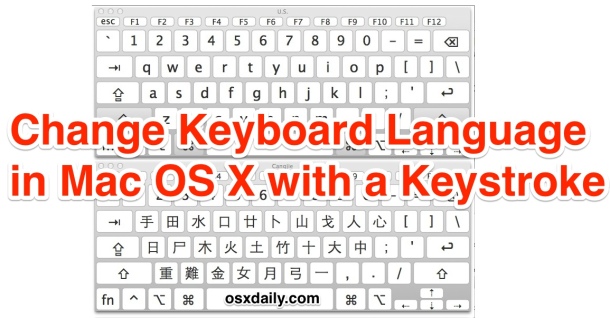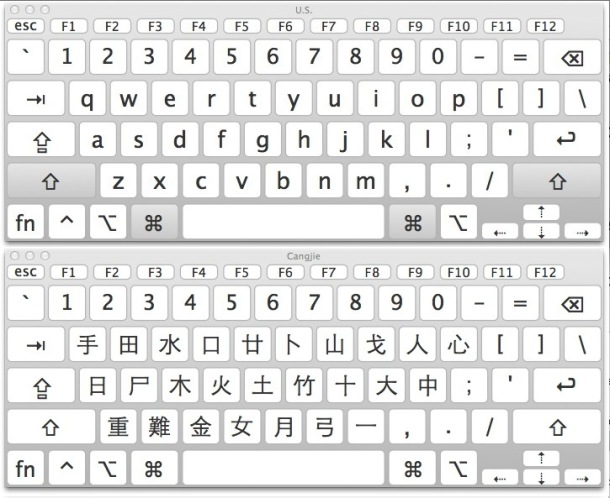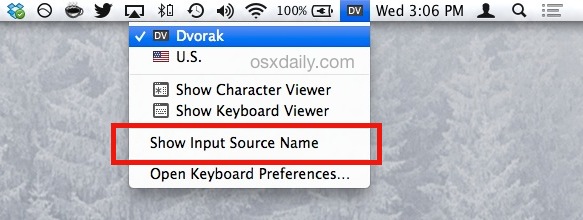How to Change the Keyboard Language Being Typed with a Keystroke in Mac OS X

If you’re bilingual, trilingual, or even just use an alternate keyboard input method from QWERY like DVORAK, you can make your typing life much easier by setting up a keyboard shortcut in Mac OS X that instantly changes the typed language. This shifts the keyboard to your other language or typing layout option(s), from an English keyboard to Chinese keyboard for example, with a quick keystroke entry. Additionally, we’ll cover a simple trick that provides a system-wide indicator of what is the currently active language or keyboard being used on the Mac, so you’ll always know exactly what language is active without having to type to find out.
This should probably go without saying, but you’ll need at least one other keyboard input source or language added to OS X for this to work, otherwise there’s nothing to switch between. If you haven’t added the other language keyboard yet but are waiting to do so, that can be done through System Preferences > Keyboard > Input Sources > and clicking the + plus button to select your language(s) of choice. That’s also where you can add another keyboard layout, like DVORAK.
Set the Language Switching Keyboard Shortcut for Mac OS X
This trick makes switching your active typing language as simple as a keystroke:
- Open System Preferences in OS X and go to “Keyboard” panel
- Choose the “Keyboard” tab and check the box for “Show Keyboard & Character Viewers in menu bar” – this enables a handy indicator in the menu bar to let you know what language / keyboard is currently active, more on this in a moment
- Now go to the “Shortcuts” tab and click on “Input Sources”
- Check the box next to “Select next source in Input Menu”, then click the cursor into the field to the right to set the keyboard shortcut to switch the language – in this example we used Command+Shift+Option+Spacebar but you can pick whatever you want that doesn’t conflict with another keyboard shortcut
- Open TextEdit or another text editing application to test it out, then hit your keyboard shortcut (or ours; Command+Shift+Option+Spacebar) to switch the keyboard and/or language being typed
- Close out of System Preferences once confirmed to be working

Switching the Keyboard Languages with the Keystroke
You can hit the same keyboard shortcut again to switch back to English or whatever the other language setting is. Or, if you have more than two languages and keyboards added to the Mac, you hitting the keystroke will simply toggle to the next one.
If you use the virtual onscreen keyboard you’ll notice that language or keyboard layout changes there too.

This works really well, and yes it shifts the spelling tool and autocorrect as well if you’re in a new language with a respective dictionary. Using a keyboard shortcut is much faster to switch the current language than doing so manually through the keyboard input menu, this is really probably the fastest way to toggle keyboards and languages in OS X. Speaking of that input menu, let’s enable one final option that’s really handy.
Enable a Keyboard / Language Indicator in the Mac Menu Bar
In the second step above, we enabled an optional menu item for the keyboard, now we’re going to make that even better by turning it into a live language indicator for OS X:
- Pull down the input menu (usually displays a flag of the default keyboard type), and select “Show Input Source Name”

That’s it, now when you hit the aforementioned keyboard shortcut that you just set, you’ll also see a visual indicator in the menubar of which keyboard and/or language is currently active in Mac OS X.



Thank you that works like a dream x
Thanks a bunch! Works perfectly. (OS X Catalina)
you guys are awesome
This was a great tip. I figured (hoped) there was a keyboard shortcut way to switch between keyboards, as having to click on the menu bar icon to switch is pretty inefficient.
Thank you!
thank you so much
OMG I LOVE YOU!! Thank you!!!
Thank you very much, this helped me a lot.
Regards,
Bogdan
a zillion thanks mate!
thanks, it works
Thank you very much!
It was very usefull!
Worked like a charm, many thanks.
I want to change language, spelling et al BUT stick to the same keyboard layout all the time….
Thank you so much.!!
Thank you very much. :D
Successful set a new shortcut for my language setting.
I left a comment above about the tool which you can use direct shortcut key of changing languages.
Today I updated the tool and you can use the shortcut on the virtual PC like Parallels Desktop or VMWare Fusions now.
It’s all free and might be useful for you.
http://seoul-life.blog.jp/archives/41177924.html
If you have any question or request, please contact me!
I’m Japanese Mac user and studying Korean.
In fact this keystroke(command+space) is very annoying for multilingual user(more than 3 languages) to change languages.
I also have to change language 50times a day, and wanted a shortcut key.
But there was no way to change input source by direct shortcut key.
So I made a original code on Karabiner program.
If you want to switch 3 languages rapidly, the way will help you so much.
I introduced this tool on my blog.
http://seoul-life.blog.jp/archives/30821467.html
I hope this will help you!
thank you.. that’s what i’m was looking for :)
We opted for a 2-key combo, so ctrl+Space was chosen.
Also, I need to be able to determine what the *default* language will be. does anyone know how to set the default language ? \ switching order?
Thanks!
I tried to use the virtual onscreen keyboard but switching between chinese simplified and US, doesn’t change the virtual keyboard layout. I use OSX 10.9.5.. Am I doing something wrong?
I only use the one off method for vowels and the occasional consonant rather than switching the entire keyboard. For those that don\t know what I mean, just keep any vowel pressed until the variations pop up on screen and then select by typing the number. Alas, works only for European languages…
This is something I have used for years and is one of my favourite keyboard shortcuts.
I have a macbook air with an English Keyboard and a Swedish wireless keyboard so I find myself using this shortcut quite a few times a day.
I use CMD+ALT+Space though as I find it easier.
I have mine set so that, system-wide, it’s Command+Option+Down. I use that to switch between English and Japanese >30 times a day.
Works really well on my MacBook and is more intuitive than someone reading this may think. I recommend it.
Command+Shift+Down, rather. Whoops.
Will give this one a shot for a while!
This strikes me as really odd choice of a shortcut. Perhaps the writer himself hasn’t used a second keyboard, otherwise he’d mention that Apple’s default shortcut for switching languages is cmd+space and it really convenient (spotlight can then be set for opt+cmd+space or ctrl+space, which is pretty convenient as well). When you’re bilingual hitting four buttons hundreds times a day is rather uncomfortable. (Or maybe it was a joke and I just didn’t get it.)